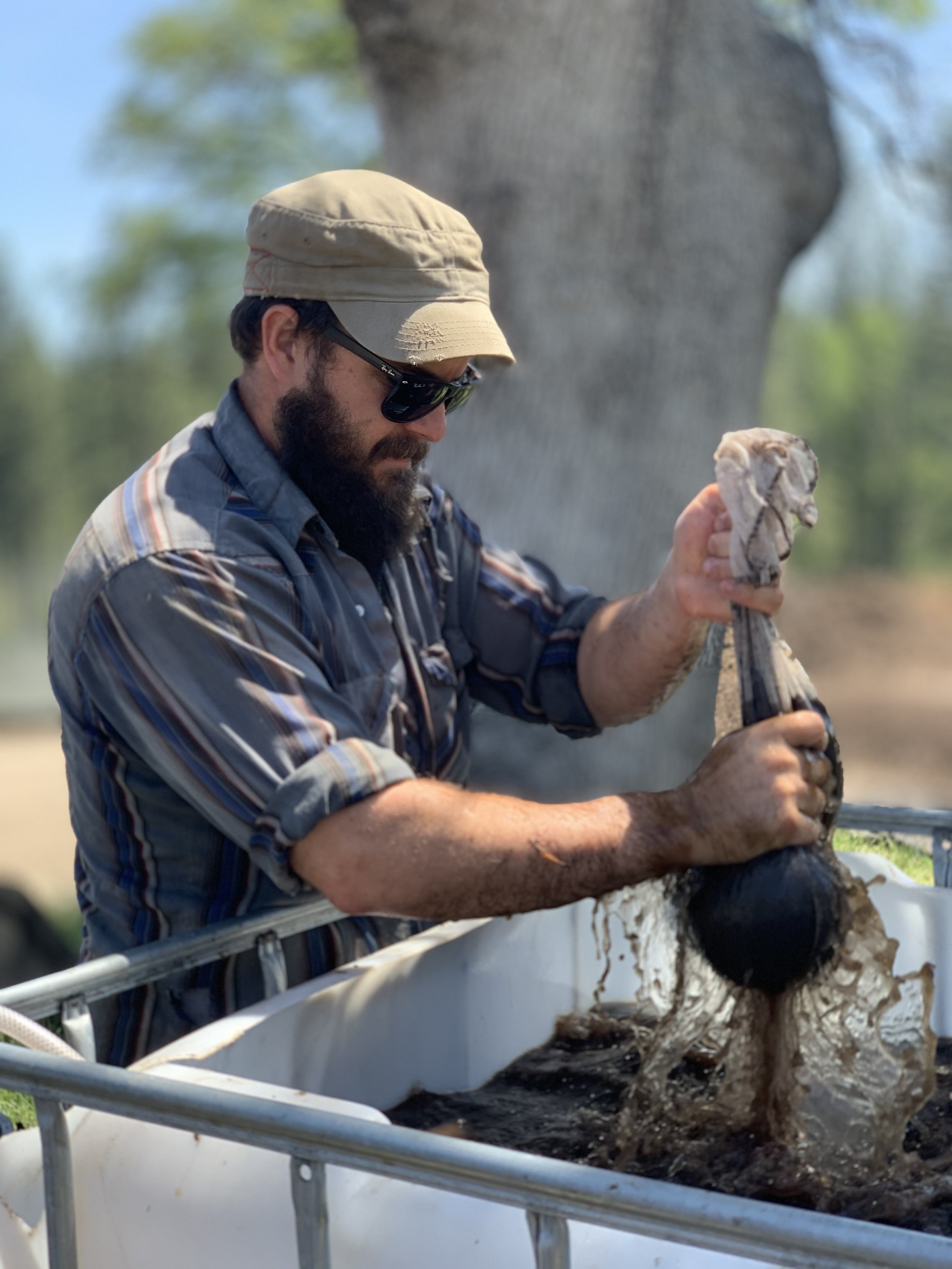WITCH’S BREW: DEMYSTIFYING THE SOIL FOOD WEB, COMPOST TEAS AND EXTRACTS
If you get to talking with a soil, plant, or farming nerd about their craft there is a solid chance that the terms “soil food web,” “compost tea” or “compost extract” will come up. Though they may sound a bit distasteful, even witchy, they are definitely worth looking into as they provide a great service to plants and soils. Think of them as the ultimate super food for your garden ecosystem. Humans spend tons of money drinking concoctions made of reishi mushroom, goji berries, wheatgrass, and the like to improve our gut function and give us energy to perform better. Why not give your garden the same consideration?
Soil is the foundation upon which we build all healthy landscapes. When we foster healthy soils, they support resilient plants that are resistant to disease and pests. Healthy soils also require less pesticides and fertilizers, keeping them out of our storm drains and protecting our river.
So let’s get into it. We’ll start with an explanation of soil and the soil food web, break down the differences between compost teas and compost extracts, and why it is so important to care for and build regenerative soil.
So what is soil?
First of all, soil is not to be confused with dirt. They are vastly different, and often mistaken for one another. Dirt is the mineral parts of soil–clay, sand, and silt but is devoid of biology (life).
Soil, on the other hand. . .
Photo: RickStrater.com
That’s right. Soil–combined with its food web– is a living, breathing entity. It is composed of organic matter, bacteria, fungi, microorganisms, plant material, pebbles, rocks, sand, silt, clay, air and water. Dirt is just one ingredient in soil, while the microorganisms are what bring it to life. Think of it like sourdough bread baking. . .soil is the dough: microbes are the life-giving yeast to the bread dough. . . all of you pandemic burgeoning bread bakers can relate.
And just as one needs to constantly feed the bread starter to keep it happy and healthy and produce a delicious end product, soil needs to be fed as well for happy and healthy plants. And fed with good stuff, like organic material, microbes, fungi, water and air. Healthy, regenerative soil–like soil one would find in the forest floor– is able to feed itself and improve with every year in the right conditions. It does this with the help of the soil food web.
Photo: www.soilfoodweb.com
So what the heck is the Soil Food Web?
It is an elaborate community of subsurface microbes, insects, fungi and bacteria, roots and organic matter interacting with plants, animals, sunlight, air and water to create a complex living system that helps break down nutrients in the soil, making them bio-available to the plants.
Without healthy soil (and a robust soil food web), plants are not able to suck up and utilize the nutrients. . .so yeah, all of that fancy fertilizer you purchased for your landscape? If your plants aren’t able to uptake the nutrients, those excess nutrients can get flushed down the storm drain. That’s money and pollutants down the drain!
Still not quite sure how the soil food web works?
See this link for a quick 6 minute video explaining the soil food web.
Caption: Gregory Munn (left) and cofounder Keisha Wheeler (right) of Catalyst BioAmendments. Keisha is seen preparing a compost extract in 5 gallon buckets. Gregory is injecting a compost extract with a subsoil injector that is attached to a hose, and then attached to a 200 gallon drum full of the liquid concoction. This is an effort to build soil and its biology in a previously nutrient and biology-deficient planting bed.. Location: Biggest Little Dog Park, Commercial St. and Sierra St. in downtown, adjacent to the new Locomotion Plaza.
Ok, I understand the soil food web now. So what’s the deal with compost teas and extracts? What’s the difference?
Both of them are superfoods that help feed that soil food web that will in turn help build up soil. They have bacteria that make the glues that bind and hold sand, silt and clay to the root systems (Ingham). They are power-packed with microbes [microscopic (“micro-”) critters that eat nutrients and poop them out for the plants to suck up] and can be used in a number of methods:
Compost extract “is a watery extract made from compost suspended in a barrel of water for no more than one hour before use, usually soaking in a burlap sack. It is massaged gently to release the microbes into the water. This provides soluble nutrients as well as microorganisms, which can be used as a liquid fertilizer. However, it will lack sufficient holding time for microorganisms to multiply and grow significantly.” (Cal Recycle)
Apply the extract to the root zones of the plants you wish to treat. You may see signs of soil life, such as fungi, soon after application. Let them be, and fold back into the soil and smile knowing that you’re starting to build biology in your soil.
Compost teas “. . . are actively brewed with microbial food and catalyst sources added to the solution, and a sump pump bubbles and aerates the solution supplying plenty of much-needed oxygen. This extracts beneficial microbes from the compost itself, and grows these populations of microbes during the 24- to 36-hour brew period. The compost provides the source of microbes, and the microbial food and catalyst amendments promote the growth and multiplication of microbes in the tea. (Cal Recycle).
Photo courtesy of Catalyst BioAmendments, Nevada City. Above,co- founder Casey Ernst processing compost tea.
Application: compost teas can be applied to leaves, trunks and stems of plants and trees with a backpack sprayer with a sump pump and garden hose set up. Best to apply in cooler (morning or evening), dry conditions, with little wind.
Caption: Gregory Munn of Catalyst Bioamendments applying a compost tea to elm trees infested with elm beetle. The tea will act as a biocontrol to help strengthen the immune system of the tree in the fall. In the spring, he will reapply the compost tea, and apply tree tape inoculated with compost extract to trap the larvae that migrate from the soil up the trunk to the leaves.
Photo: rosepetal236 (flickr.com) caption: earthworms breaking down organic material to create soil
Why is soil so important?
Simply put, we cannot live without soil. “Soil is the linchpin to our living systems . . . it is the medium of life, and from which, all life springs, maintains itself, and returns.” (Powers, pg.8). With regenerative soil, comes greater water retention, higher nutrient content which leads to healthier plants and sequestering of atmospheric carbon.
Ancient civilizations–Roman, Mayan, Grecian, etc– all fell in part due to soil degradation. But soil can most certainly live without us. So if we humans would like to prolong our existence on this planet, we must tend to and build regenerative soil.
A call to action
“It takes an average of 500 years to naturally build an inch of topsoil, and we are losing it at 17 times that rate” (Our Climate Change). It is often our wildlife and plantlife that get the most press for their decline these days, but we overlook the crucial living being that supports all of that biodiversity, just underneath our feet.
Building soil is one of the most powerful acts we can do as humans on this planet and it is completely within our reach. It doesn’t require much money or resources. Just time and effort. The more care we collectively put into our landscapes and into growing healthy soil, the happier and healthier our local watershed will be.
Resources
Dr. Elaine Ingham Building Soil Health for Healthy Plants by soil scientist Dr. Elaine Ingham Youtube video Building Soil Health for Healthy Plants by soil scientist Dr. Elaine Ingham
Compost Teas vs. Other Teas, https://www.calrecycle.ca.gov/organics/compostmulch/composttea/otherteas
Powers, Matt. Regenerative Soil: The Science and Solutions.
Our Changing Climate Why Soil Matters
Do We Treat Our Soil like Dirt? National Geographic https://www.nationalgeographic.org/article/do-we-treat-our-soil-dirt/
Montgomery, David R. Dirt: The Erosion of Civilizations. https://academic.oup.com/bioscience/article/58/4/363/310371







